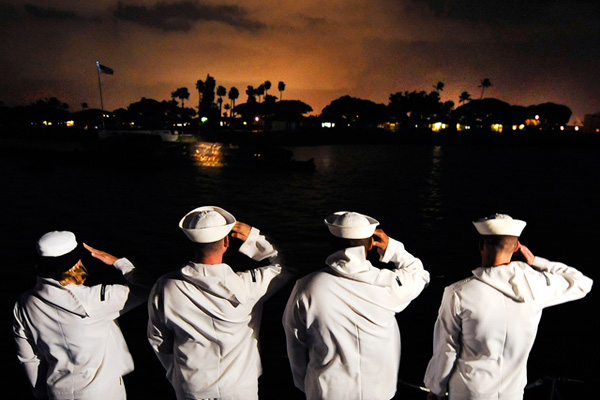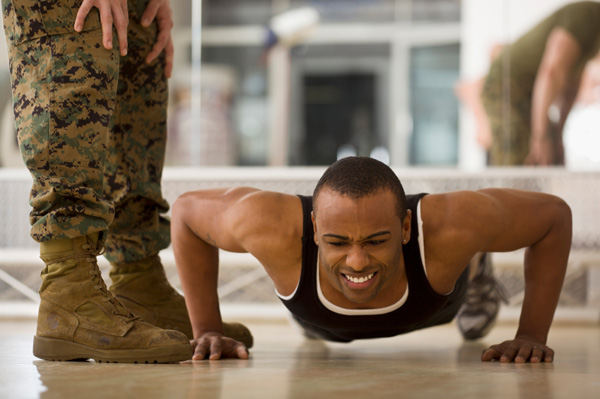Obesity is rampant across the entirety of the US population. Epidemic is one word often used to describe the increasing weight that is creeping in on more than half of our citizens. For as sexy as they can look in those sailor suits, and physically demanding their jobs can be, even the members of the US Navy aren’t immune. The National Institutes of Health reported in November that 15.1% of male US Navy personnel are obese. However, for the confined space they often live in on submarines, the obesity rate “remains below U.S. nonmilitary comparison data.”
Posted on the Navy Times today, the problem is something that they’re asking for crowd-sourced support in alleviating, even if that means from civilians. The publication posted that, “A recent audit of the Navy’s fitness program revealed that many commands do not take fitness seriously, and that there’s too little accountability at the top.” In a business where fitness is everything, much like law enforcement or firefighters, the physical fitness should be a priority to everyone.

Navy Times is asking people to email their thoughts on both personal experiences regarding fitness in the Navy (for instance, “are you allowed time to work out?”) and how to improve the fitness of the Navy. While they’re likely looking for answers primarily from their own men and women, they’ll no doubt hear from anyone who stumbles across the article who want to share their two cents. Like us!
We’ve got ten tips for the Navy to improve the fitness of its personnel. When people are fitter and healthier, and encouraged to be so, they think clearer, have fewer days off work, are more productive, not to mention generally have better overall morale. We’re sure all of this would be appreciated by everyone in the Navy, from the top down.
Be Accountable. Enact a buddy system where each person is accountable to another for their workouts, diet habits, and even other health changes like smoking. This shouldn’t be a commanding officer, but a peer, that way you eliminate any fear. The relationship should be supportive and mutually beneficial.
Stand Up. Get rid of the space-eating standard office desks and install standing desks. This will get your personnel up out of their chairs and on their feet, which promotes more movement, better posture, and overall better fitness.
Promote Personal Training. Certifications, that is. The NESTA personal training certification is now covered under the GI Bill tuition allowances. It can help individuals not only prepare for a career after the Navy, but help them keep themselves and their peers in shape during.
Clean Up the Mess. The mess hall that is. This is a bigger action than just making sure people are allowed a mid-day fitness break. But the pre-packaged, processed foods that are largely served in military cafeterias have got to go. Follow your Commander In Chief’s wife’s Let’s Move! initiative to clean up American school lunches and use it as a model for improving the quality of food being served on your bases and ships.
Weight Watchers at Work. The Navy is a job like any other and there’s no reason that this 50-year old program won’t work for your men and women, too. Weight Watchers at Work actually eliminates the need for men and women to make time to go to off-site meetings and instead brings this balanced program right in to your office for meetings, support, and education.
Install Primal 7. This is the most impressive piece of fitness equipment we’ve seen in a very long time. Primal 7 is a suspension training system that mounts on a wall or above a door and offers an all-in-one cardio, weight, core, and strength training workout. In as little as 11 minutes (as long as a smoke break) you can get a total body, very efficient workout. In the confined, limited space of a submarine, this would be much more feasible than a standard gym. The guys at Military Times have already tried it and love it.

Fitness Happy Hour. Host 30-minute or one-hour events weekly where people can learn about a broad number of health-related topics. One week it could be reading food labels, another everyone learns how to do a proper push-up, and another week it’s a healthy cooking demo. Everyone gets to be involved and make healthy living more social.
Grow a Garden. Work with the spouses’ clubs on each base to grow community gardens that all members of that Naval community can access. This makes fresh fruits, vegetables, and herbs readily available to everyone who wants them.
Update the Vending Machines. It’s time to do a major spring cleaning on those electronic junk food boxes. Replace the soda with water, tea, and even sports drinks. Request refrigerated snack machines for yogurt, cheese, and fruit, or remove most of the candy bars and chips and replace with trail mix, dried fruit, and nuts. A new study from the University of Montreal says that quitting junk food is liken to quitting addictive drugs, so you can’t make this change soon enough.
Tie in Bonuses! If you’re having to convince people to get on board with these healthy changes, then make it more worth their while (as if fighting off obesity wasn’t gift enough). Offer extra vacation days, cash bonuses, or even donated gifts from the community like restaurants, shopping, and hotel stays for those who lose the most weight, maintain a weight, or maintain or improve their health from one annual physical to the next. It’s a corporate wellness model that works very well.
In 2004, the Navy announced the “Get Moving, Navy” program, an internal initiative “to motivate military personnel and their families toward healthier food choices, fitness habits and lifestyles.” Eight years later, we have to wonder if it’s working. In that announcement they cited that 80 percent of recruits who exceed weight-for-height standards at the time they enter the military resign before the end of their first term of enlistment.
In the Army, recruits who don’t meet weight standards have to have a waiver to enter, pass physical ability tests, and have one year to meet the Army’s BMI standards, according to MilitarySpot.com. That organization announced a new fitness program in 2025 that incorporated Pilates, yoga and less standbys like running and sit-ups.
The concept of “too fat to fight” has been discussed at length in the media in recent years. We hope the Navy is able to use even one of our tips on its way to improving the fitness of the men and women working so hard to protect and serve us all. After all, even Michelle Obama has been quoted as calling this, “not just a health issue but a national security issue.”
Also Read:
The Hunger Games’ Military-Style Workout
25 Most Popular Diets of 2025
top image credit U.S. Air Force Master Sgt. Jerry Morrison

